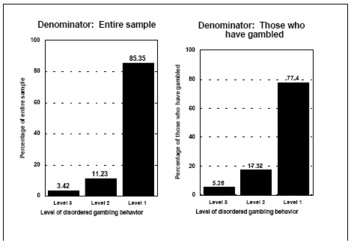A prevalence estimate, or the proportion of a population who have a particular health condition at a point or period in time, is calculated by dividing the numerator (those with the disorder) by the denominator. Embedded in every prevalence estimate is an assumption about who is included in the denominator. Within the problem gambling research field, the denominator of prevalence estimates traditionally has included the entire sample, including those who have never gambled. For example, in a telephone survey of adults in Massachusetts, the conventional prevalence estimate would be the number of adults who met criteria for pathological gambling (numerator) divided by the entire sample of adults interviewed (denominator). This method assumes that all individuals, even those who have yet to gamble, are at risk of having a pathological gambling disorder. Alternatively, the at-risk group has been viewed as only those who have gambled during their lifetime. In this model, those at risk of having disordered gambling behavior are only those who have gambled during their lifetime. An individual who has never gambled is not considered to be at risk for disordered gambling. The implications of these two ways of viewing the at-risk group and the two ways of calculating prevalence estimates are important. Prevalence rates of pathological gambling (or level 3 gambling*) will be higher if the denominator includes only those who have gambled in their lifetime. For example, in a recent study conducted in New Mexico among 1279 adults**, 3.42% of the entire sample met criteria for level 3 gambling, while 5.28% of those who had gambled met level 3 criteria. Similarly, 11.23% of the entire sample met criteria for level 2 (at risk or in transition) gambling, while 17.32% of those who have gambled met level 2 criteria. Prevalence estimates must be disseminated and interpreted with a clear understanding of who is included in the denominator. In addition, researchers and others in the gambling research field will benefit from continuing the dialogue to determine who, in fact, is at risk for disordered gambling behavior.
Sources:
*Shaffer, H.J., & Hall, M.N. (1996). Estimating the prevalence of adolescent gambling disorders: A quantitative synthesis and guide toward standard gambling nomenclature. Journal of Gambling Studies, 12(2), 193-214.
**New Mexico Department of Health, & University of New Mexico Center on Alcoholism, Substance Abuse and Addictions. (1996). New Mexico survey of gambling behavior. Santa Fe, New Mexico: Author.
This public education project is funded, in part, by The Andrews Foundation.





